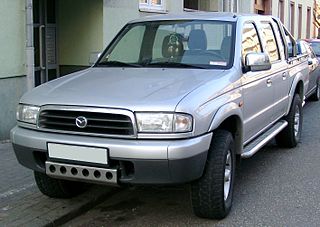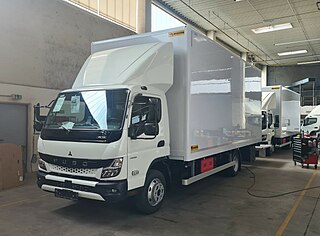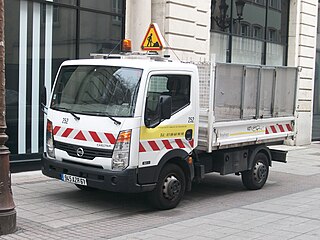
The Mazda Bongo, also known as Mazda E-Series and the Ford Econovan, is a cabover van and pickup truck manufactured by the Japanese automobile manufacturer Mazda since 1966. The Bongo name was also used for the Bongo Friendee, which is not a cabover design.

The Nissan Patrol is a series of large four-wheel drive vehicles manufactured by Nissan in Japan and sold throughout the world.

The Mazda Titan is a commercial truck produced by the Japanese automaker Mazda since 1971. From the fourth generation onwards, the vehicle had become a rebadged Isuzu Elf truck.

The Toyota Stout is a light truck produced by the Japanese automaker Toyota from 1954 through 1989. The Stout shared its platform with the Toyota Dyna until 1968, when the Dyna was given its own platform, called the Toyota "U". In Japan, it was sold at Toyota Japanese dealerships called Toyopet Store.

The Renault Master is a large van produced by the French manufacturer Renault since 1980, now in its third generation. It replaced the earlier Renault Super Goélette light trucks. Opel has sold versions of the second and third series vans as the Opel Movano in Continental Europe and Vauxhall Movano in the United Kingdom. All three generations have been designed and manufactured by Renault, irrespective of the brand. Renault Trucks markets it as the Renault Trucks Master.

The Prince G-series engine was the company's only straight-four and straight-six engines which began production in 1955. A number of variations were made, with both OHV and OHC heads. A diesel four-cylinder with 1.9 L (1,862 cc) was also built, called the D-6. The G series was used in the Skyline, the Laurel, and the Gloria from the 1950s to the early 1970s.

The Nissan Cedric is a large automobile produced by Nissan since 1960. It was developed to provide upscale transportation, competing with the Prince Skyline and Gloria which were later merged into the Nissan family. In later years, the Nissan Skyline was positioned as a sports sedan/coupe, whereas the Nissan Gloria was turned into a sporty version of the Cedric.

The Mazda B series is a series of pickup trucks that was manufactured by Mazda. Produced across five generations from 1961 to 2006, the model line began life primarily as a commercial vehicle, slotted above a kei truck in size. Through its production, Mazda used engine displacement to determine model designations; a B1500 was fitted with a 1.5 L engine and a B2600, a 2.6 L engine.

The Datsun Truck is a compact pickup truck made by Nissan in Japan from 1955 through 1997. It was originally sold under the Datsun brand, but this was switched to Nissan in 1983. It was replaced in 1997 by the Frontier and Navara. In Japan, it was sold only in Nissan Bluebird Store locations.

The Toyota Dyna is a light to medium-duty cab over truck for commercial use. In the Japanese market, the Dyna is sold alongside its twin called the Toyoace. The Toyoace was a renaming of the Toyopet SKB Truck as a result of a 1956 public competition with 200,000 entries. "Dyna" is short for dynamic.

The Mitsubishi Fuso Canter is a line of light-duty commercial vehicles manufactured by Mitsubishi Fuso Truck and Bus Corporation, part of Daimler Truck, subsidiary of Mercedes-Benz Group. The Canter is manufactured since 1963, now in its eighth generation. The Canter is named after the English word describing the gait of a horse, emphasising the 'thoroughbred' nature of Mitsubishi trucks.

The Isuzu Elf is a medium duty truck produced by Isuzu since 1959. Outside Japan it is known as N series and Q Series. The range was originally mainly available in Japan and other Asian countries. Australia was another important market for the Elf and N series – to the extent that it was manufactured there from the 1970s using many local components. Since the early 1980s, it has also been sold and built in the United States, and also as the Isuzu N-Series. Only North America receives the wide-cab version.

The Nissan Civilian is a single-decker minibus built by Japanese automaker Nissan since 1971. It is primarily available as a public bus and an intercity bus. In Japan, it was exclusive to Nissan Store locations, and replaced the Nissan Echo, which was introduced in 1958. The Echo's chassis code continued to be used on the Civilian (GC340), reflecting their shared underpinnings with the Nissan Caball (C140/240/340).

The Suzuki Carry is a kei truck produced by the Japanese automaker Suzuki. The microvan version was originally called the Carry van until 1982 when the passenger van versions were renamed as the Suzuki Every. In Japan, the Carry and Every are kei cars but the Suzuki Every Plus, the bigger version of Every, had a longer bonnet for safety purposes and a larger 1.3-liter 86-hp (63 kW) four-cylinder engine. They have been sold under myriad different names in several countries, including those with Chevrolet and Ford badges.

The Isuzu Faster is a pickup truck that was manufactured and marketed by Isuzu between 1972 and 2002 over three generations. The Faster was succeeded worldwide by Isuzu D-Max, except in Japan and North America.

Nissan Cabstar is the name used in Japan for two lines of pickup trucks and light commercial vehicles sold by Nissan and built by UD Nissan Diesel, a Volvo AB company and by Renault-Nissan Alliance for the European market. The name originated with the 1968 Datsun Cabstar, but this was gradually changed over to "Nissan" badging in the early 1980s. The lighter range replaced the earlier Cabstar and Homer, while the heavier Caball and Clipper were replaced by the 2-4 ton range Atlas (kana:日産・アトラス). The nameplate was first introduced in December 1981.The Cabstar is known also as the Nissan Cabstar, Renault Maxity and Samsung SV110 depending on the location. The range has been sold around the world. It shares its platform with the Nissan Caravan. In spring 2014, Cabstar is now known as NT400.

The Toyota ToyoAce is a light to medium cab over truck built by Toyota since September 1954. Until a renaming contest in 1956, the truck was sold as the "Toyopet Light Truck SKB". Since 1985 the ToyoAce and Dyna truck lines have been merged, with the Dynas generally being intended for heavier duty work. In Japan, it was exclusive to Japanese Toyota dealerships called Toyopet Store.

The Nissan Junior was a series of medium-sized pickup trucks built from 1956 until 1982. It was introduced to fill the gap between the smaller, Datsun Bluebird based Datsun Truck, and heavier load capacity Nissans under the Nissan Diesel brand, like the 80-series trucks. After the merger with Prince Motor Company, the Junior and the Prince Miler were combined, sharing most of the characteristics, with the Junior sold at Nissan Bluebird Store Japanese dealerships, and the Miler sold at Nissan Prince Store until 1970.

The Nissan Caball is a light commercial truck manufactured by Nissan Motors from December 1957 until December 1981. The Caball was mainly sold in Japan, Hong Kong, South East Asian countries, Australia, New Zealand, and few European countries and shared the Nissan Junior platform. While the Caball name came to an end in 1981 with the cancellation of the Junior, its larger replacement received the Nissan Atlas name in the domestic Japanese market. These are 2-4 ton trucks, the lighter versions in the Atlas truck range took over after the lesser Cabstar/Homer. In Japan, it was available at Nissan Store locations and replaced by the Nissan Atlas.
The Toyota Massy Dyna (トヨタ・マッシーダイナ) is a four-tonne medium-duty truck built by Toyota between 1969 and 1979. It could seat three.




















